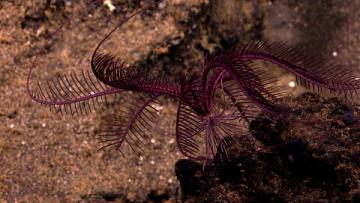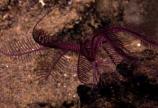Maiden voyage of international scientific program
- Krista Zala

The robot lands on the seafloor with a gentle thud. As its camera slowly swings around, we see a black basalt floor stretching into the darkness. Hundreds of meters above, the ship bobs in the calm waters off Indonesia as its control room bustles with activity. When the first creature pops into view, a new voice chimes in.
"Hey, Santiago, I win. It's crinoids first," says UVic marine biologist Verena Tunnicliffe. But she's not in the control room—she's not even talking to anyone there. Tunnicliffe, the Canada Research Chair in Deep Ocean Research (biology/SEOS/VENUS), is watching the expedition from a station in UVic's Bob Wright Building and talking to Santiago Herrera, a coral expert on watch at the Woods Hole Oceanographic Institution in Massachusetts.
Welcome to telepresence: the next generation of scientific cruises. Using real-time video, audio and data, all the action from the seafloor as deep as 3500m is beamed from the robot's camera to the ship to a satellite to shore stations across the world. Just two scientists are on board the ship; the rest offer their ideas and requests from their sites across North America and Indonesia. All input is channeled through the chief scientist on shore to John Sherrin, the scientific coordinator on board the vessel.
"Everything's buzzing," says Sherrin, a SEOS grad student in Tunnicliffe's lab studying hot vents on active marine volcanoes. "The pilots ask what we're looking at, and when I ask people on shore, I immediately get four answers."
Telepresence changes the realm of possibilities for scientific expeditions. Researchers and students can join for a few hours or a few days rather than having to commit to weeks at sea. When an unusual species comes into view, a scientist grabs a frame from the streaming video and sends it to a specialist who responds within hours—often within the same dive.
This summer's cruise marks the maiden voyage for NOAA's Okeanos Explorer, and it explored areas no one has ever seen before to look for hydrothermal vents and seeps that signal new research opportunities in biology, geology and chemical oceanography.
Each dive over the three weeks revealed more marine marvels: thousands of stalked barnacles packed onto sulphur chimneys, lumpy angler fish, delicate sea spiders, massive barrel sponges and slender, long-armed animals called crinoids, related to sea urchins and sea stars. And corals abounded, often with brittle stars or crinoids clinging to them—much to the delight of Tunnicliffe and undergrad Dustin Schornagel, who will study these animals this term.
The cruise had its challenges, of course. The charts for the area were so outdated that the crew mapped the seafloor by night and used the resulting charts for the following day's dive. Plus, the time difference meant that each day's dive in Indonesia finished around 2 a.m. West Coast time. The new environment meant dive time was often spent investigating rare and bizarre animals, although the researchers did discover hydrothermal vents on the second day.
But considering the thousands of details to accommodate—the convoluted permits, finicky telecommunications, and unpredictable weather—the cruise was a success: it mapped new regions, discovered dozens of new species, and set the stage for future expeditions.
"The whole operation is brand new, so the fact we can get this much is terrific," says Tunnicliffe. "It is a wonderful way to bring the deepsea to students at UVic and around the world." Read more about the cruise and check out images and video at: http://oceanexplorer.noaa.gov/okeanos/explorations/10index/welcome

